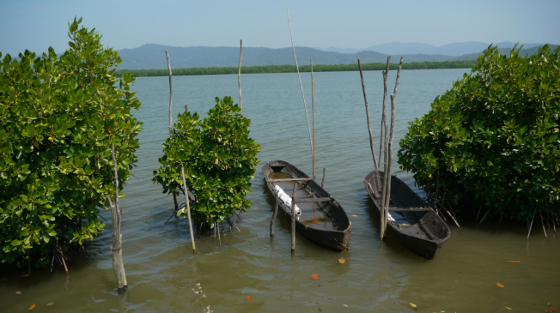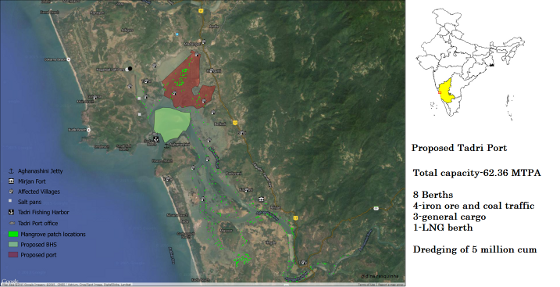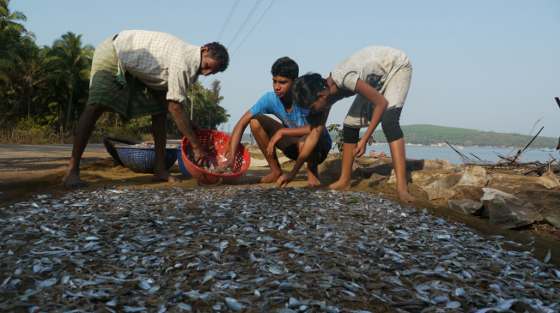Amidst the vast stretches of waters and patches of mangroves, fishers of the Aghanashini estuary get ready to lay their nets. A good season means an income of nearly $400 or close to Rs 26000 a month. But the future itself seems uncertain with the revival of the Tadri port in this estuary.
The salt pan workers on the other end of the estuary share the sentiment. Aghanashini has been transformed into a site of multiple anxieties fuelled by worries over livelihood stability and the promises of change by Tadri port – better for some and worse for others.
A socio-ecological ecosystem
The Aghanashini estuary is the lifeline of north Karnataka. The fresh waters of the Aghanashini River gather momentum from their origin in the Western Ghats and end in a picturesque estuary – a sheltered gateway to the Arabian Sea. Here, the fresh, undammed Aghanashini mixes freely with the Arabian Sea forming a unique ecosystem with varying levels of salinity that support tremendous diversity of life.
Along its banks, estuarine waves relentlessly pummel against the fringing vegetation a million times a day. The mangroves remain unmoved, despite the onslaught, practically teasing the waves. Gradually, after a fair distance from the river banks, the vast stretches of waters transition into mudflats teeming with life. The villages of Aghanashini, Tadadi, Kagal, Torke, Gokarna and several more surround the estuary and are dependent on the gifts offered by its waters, vegetation and marshes.

The Mangroves: Soldiers of the sea. Pic: Adam Jadhav
The mangroves are used as shields within which shrimp and salt-tolerant rice farming is conducted. The mudflats support a rich productivity of bivalve shellfish which are collected and sold as food, but whose shells are processed in a number of allied industries. The humble bivalve thus sustains a large number of families in the surrounding villages. The open waters are used as fishing grounds and a part of the estuary has a large salt pan set-up, which also employs numerous villagers. Apart from providing for several people living along its banks, much of this produce is also sent to areas as far as Goa and Bangalore.
There is also a flourishing tourism industry dependent on the scenic and picturesque beaches of Om, Paradise and Nirvana around Gokarna, through which many locals make a living.
However, this diversity of life and ways of living are now at the mercy of the Ministry of Environment, Forests and Climate Change (MoEF&CC). A verdict on Tadri is anticipated, as people await the decision on environmental clearance of the port, whose public hearing many attended in March of this year.
The significant procedural requirements of this infrastructure project are said to have been met - the technical feasibility study, the Environment Impact Assessment (EIA) and the Public Consultation, though there have been several questions raised by environmentalists over these steps.
Nature & development: Intersecting landscapes
In India, one finds a parallel legal ecosystem co-existing with the natural one, the former comprising Bare Acts, notifications, orders and guidelines. This system of environmental regulation intersects with the ecosystems that we encounter walking along the Aghanashini with interesting effect.
One of the primary institutions constituted under the environmental law of the country is the Expert Appraisal Committee (EAC), which scrutinises the capacity of a site for any proposed project based on feasibility studies, an Environmental Impact Assessment report (EIA) and a public consultation/hearing. It also analyses the potential impacts from the project both to the environment and to the people living in the vicinity. Thus, the duty of the EAC is to make recommendations for the environmental clearance of an 'ideal’ project - one that is economically and socially beneficial while being environmentally just and feasible.
One cannot but question how a project such as the Tadri port may be considered an ‘ideal’ project in the context of the Aghanashini landscape and its realities.
Promises of make-believe development
The official word on the proposed port at Tadri is that it is absolutely ’essential infrastructure’, because it promises that economic revenue will be generated and also that this will translate into the development of people of the Aghanashini estuary.

Location of the proposed port, mangrove patches, proposed Biodiversity Heritage Site(BHS) and villages that will be impacted by the port. Map prepared by Dina Rasquinha
However, an examination of all the technical studies for the port show they are written to prove and not test this assumption. These studies are heavily premised on a number of beliefs.
First, it is believed that the export of mineral ores from the Bellary-Hospet region will continue for several years from Karnataka’s ports.
Secondly, it is believed that no other ports will compete for exporting these items.
Thirdly, it is believed that other crucial infrastructure will also be inserted into the Western Ghats landscape, such as the Hubli-Anokla railway line and the widening of the NH 63.
Finally of course, the economic benefits are not challenged by the costs of port construction and operation on the local livelihoods, and this sort of math is infinitely useful in make-believe development. It’s hard to wholeheartedly embrace this reasoning and it calls for a closer examination.
Economic feasibility or cost-benefit analysis, anyone?
Economist Jacob John flatly rejects the idea that any economic study was conducted for the project.
He says, “The project proponents haven’t conducted an economic feasibility study of the port, discussing the likely proceeds from the existence of this port or the savings that the different stakeholders would be making by using the Tadri port facilities, as opposed to the facilities at other competing ports. There is also no study that addresses the costs or benefits to the local communities dependent on resources from the estuary or on the Western Ghats which is in close proximity to the port site”.
Thus, the existing ‘technical feasibility study’ merely outlines the relevance of the site for a port but fails to list the economic feasibility of a port itself.
No competition?
The state of Karnataka has 12 ports, some of which have similar facilities and expansion plans as foreseen for Tadri. The ports at Goa and Andhra Pradesh, too, are in close proximity to Bellary-Hospet. The technical feasibility study fails to effectively analyse the expansion plans of these competing ports. It bases all predictions of increasing exports/imports assuming a linear growth mechanism which may not always be the case.
Moreover, the anticipated growth is dependent on connectivity to the hinterland by road or rail which is still not guaranteed. Environmental clearances for both, the widening of the NH63 highway and the Hubli-Ankola railway line are still awaited, as these projects require deforestation of dense forests of the Western Ghats. Unmindful of existing competition or absent supporting infrastructure the technical report assures us that we must believe that the port will be a profitable investment.
Environment non-assessment
The play of fresh and sweet water creates a gradient of salinity, nutrients and organic matter within Aghanashini and this sustains a biologically rich, diverse and productive environment. These areas play a key role in filtering pollutants from water, balancing the eco-hydrology of the region and providing a habitat for birds, molluscs, crustaceans and numerous other kinds of ecologically and commercially important species.

Sun-drying of fish at Aghanashini village, Kagal. Pic: Adam Jadhav
Studies on the Aghanashini estuary indicate about 90 estuarine-resident and dependent fish species, 120 resident and migratory bird species, 12 mangrove species and several mangrove associates. This rich diversity has also compelled the Forest Department to propose this area as a ‘Biodiversity Heritage Site’.
One would expect the EIA report to have thoroughly investigated the mentioned concerns but several citizen groups, many of whom are locally based, have criticised the EIA study on several grounds.
They question the authenticity of the EIA study as it contains plagiarised text from several sources. The criticisms state that benefits of the port are overstated without basis, draws minimal attention to the destruction of flora and fauna and the estuarine habitats due to port construction and related dredging activities.
The EIA study also omits the presence of certain ecosystems such as mudflats. It misses many important aspects, including the impact of invasive species introduced by ballast water exchange.
Additionally, the study pays little or no emphasis on the number of livelihoods dependent directly and indirectly on the services from this estuary. It fails to recognize the free gifts bestowed by Aghanashini on its farmers, fishers, bivalve collectors and salt pan workers and promises (without guarantee) untold employment opportunities from the port instead.
Public consultation
The EIA Notification also provides for a ‘public consultation’ which is supposed to provide concerned stakeholders an opportunity to raise their anxieties about the proposed project. It also gives them a space to question and seek answers from project proponents regarding the potential impacts and benefits to their livelihoods. This is meant to epitomise citizen participation in environmental decision making.
An earlier article on India Together elaborated on the various procedural irregularities that marked the conduct of the public hearing related to Tadri.
Surprisingly, a private proponent has not yet been identified for the port. For the public hearing, the Karnataka State Industrial and Infrastructure Development Corporation (KSIIDC) stepped in to defend the port project. Citizens raised a number of questions at the hearing, some of which were directed towards the KSIIDC in the absence of a private proponent and the nodal officer from the EIA consultancy agency NEERI, Nagpur.

Listings of absurdities in the particular EIA were raised at the hearing, which include discrepancies in GPS co-ordinates within the EIA study and the fact that the current fishing harbour was completely forgotten in the Tadri plans.
The critiques also listed a number of ways in which the activities of the port would actually interfere with current fishing and other livelihood endeavours: through direct pollution, restrictions on movement, destruction of habitats and the illegal appropriation of common property resources.
The challenges to the belief in Tadri as development were fielded by KSIIDC and the EIA Consultants with a single assurance: Pollution will be minimum and they will do the best they can to preserve the estuary in its current form.
No evidence, no proof and certainly no guarantees.
The benefits of Tadri
As we await the verdict on Aghanashini, we are struck by the fact that the Tadri port proposal has indeed performed an important function. It has helped to remind us that a landscape is never what its citizens see today (as delicate ecosystems or livelihoods), but what it promises tomorrow (infrastructure and real estate speculation).
In the same way, this project has also helped resurrect an interest in how the production of technical expert documents can aid the decay of India’s environmental clearance process. Lastly, it proves that in order to justify that a project is indeed essential, the state doesn’t need to provide a reason. It only requires its citizens to blindly believe.
REFERENCES
-Chandran, SMD, Ramachandra, TV, Joshi, NV, Mesta, PN, Settur, B and Mukri, VD 2012, ‘Conservation and Management of Mangroves in Uttara Kannada, Central Western Ghats’, ENVIS Technical Report: 50, CES, IIsc
-Nayak, VN 2011, Survey of Kali and Aghanashini to declare as heritage sites, submitted to the Karnataka Biodiversity Board
-Manuel, M and Sridhar, A. 'Submission to the Karnataka Pollution Control Board regarding the proposed minor port in Tadadi, in response to the Public Consultation process as per the EIA notification, 2006'.























